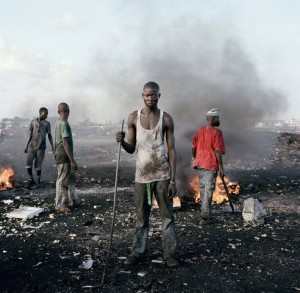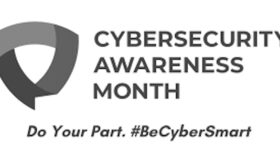Technology’s Dirty Secrets Series – E-Waste and Technology Pollution
 Technology makes our lives easier. But the world we live in has hidden corners where others suffer for our easy life. E-waste and technology pollution is wrecking the environment especially in third world countries. Some countries on the African continent are poisoned and polluted by the technology industry we hold so dear in the United States and the western world. This is the dirt and blood that coats the billions of dollars made manufacturing, selling and disposing of technology. In this series the African-American Cyber Report will expose the dirty secrets of the technology industry. In this third and final article of this series we examine the practice and victims of electronic and technology waste disposal.
Technology makes our lives easier. But the world we live in has hidden corners where others suffer for our easy life. E-waste and technology pollution is wrecking the environment especially in third world countries. Some countries on the African continent are poisoned and polluted by the technology industry we hold so dear in the United States and the western world. This is the dirt and blood that coats the billions of dollars made manufacturing, selling and disposing of technology. In this series the African-American Cyber Report will expose the dirty secrets of the technology industry. In this third and final article of this series we examine the practice and victims of electronic and technology waste disposal.
The explosive growth of the electronics and technology industries has also sparked a tragic onslaught of electrical and electronic waste (e-waste). In 2012, the United Nations reported that in five years, the world’s electronic waste would grow by 33% from 49.7 million tons to 65.4 million tons.
The third world industry of recycling the valuable elements contained in our e-waste such as copper and gold is both a source of income and illness and death in developing or emerging industrialized countries.
Impoverished people are using crude, even primitive techniques to harvest valuable metals from discarded electronics. One technique used is burning cables to get at the cooper wiring. This method exposes children, adults and even entire families to a range of hazardous substances.
According to the World Health Organization (WHO) these children and families suffer from e-waste-connected health risks as a result of direct contact with harmful materials such as lead, cadmium, chromium, brominated flame retardants or polychlorinated biphenyls (PCBs) because they are inhaling toxic fumes.
Not only is the air they breath severely polluted but so is the very ground they stand on. Because of our electronic waste dangerous chemicals pollute the soil, water and food. Recycling industries where workers dismantle electrical equipment with little or no safety precautions also pose the threat of injury.
One of the most polluted places on earth is Agbloboshie in Ghana’s capital of Accra. According to the Green Cross Switzerland and the Blacksmith Institute Agbloboshie is one of the 10 most polluted places in the world, thanks to toxic fumes, which are a result of consistent dumping of electronic goods. Agbloboshie has been Western Europe’s dumping ground fordiscarded electronic goods for more than twenty years. About 215,000 tons of second hand consumer items land in Agbloboshie every year, generating 129,000 tons of electronic waste.
“We estimate that the health of more than 200 million people is at risk from pollution in the developing world,” said Richard Fuller, who heads US-based environment watchdog the Blacksmith Institute.
African nations are not alone as they bathe in the west’s e-waste. Indonesia’s Citarum River Basin in West Java is home to about nine million people and 2,000 factories. The river, source of drinking water and rice farming irrigation, is contaminated by a wide range of toxins, including aluminium and manganese and tests have shown lead at levels more than 1,000 times above U.S. standards.
American’s fail to understanding of what some parts of the world is going through as we enjoy the age of technology.
A report from the the U.S. Government Accountability Office is a clear indictment of the way Americans dispose of electronic waste. American electronics recyclers appear to be shipping used equipment containing CRTs (cathode ray tubes) overseas in violation of U.S. Environmental Protection Agency regulations. But even worse is the fact that the agency’s regulations cover only the export of used and discarded CRT monitors, not other electronic equipment. So whatever e-waste we can dump on the third world is fair game.
Only 25 percent of U.S. generated e-waste is recycled. The other 75 percent goes straight to American landfills or third world nations.
The U.S. is shipping used electronic devices containing toxic substances overseas and there are few if any laws to protect these people and the environment in those countries, according to a government auditor’s report.
“Concerns have grown … that some U.S. companies are exporting these items to developing countries, where unsafe recycling practices can cause health and environmental problems,” the GAO report said. “Imported used electronics that cannot be repaired are often recycled in developing countries by crude and inefficient means and with virtually no human health or environmental protection.”
According to the GAO 20 percent of discarded electronics from the U.S. would add up to 66 million pounds of e-waste being shipped overseas each year. This wastes ends up in places like Agbloboshie.
So how do you dispose of electronic products? Check the EPA’s website or the Electronics Take Back Coalition for information about e-Stewards, which are responsible recyclers of electronic waste. If you can’t find and e-Steward near you check the manufacturer’s website or store recycling programs. For instance, Staples and Best Buy both have recycling programs.
There is also a thriving industry in the U.S. that buys old electronics or take trade ins. These include websites like Gazalle.com and BuyBackWorld.com. And for the record you can find electronic buy back programs at Walmart and Target stores.






